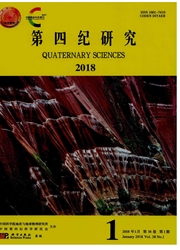

 中文摘要:
中文摘要:
依据Stokes颗粒沉降原理将黄河利津水文站和汊河清八站的表层沉积物分别提取为〈2μm,2-4μm,4-8μm,8-16μm,16-32μm和32-63μm的6个粒级,采用ICP-MS法对各个粒级沉积物的15个稀土元素进行测试。结果表明:黄河沉积物两个样品REE含量随粒度增大的变化趋势有细微差别,但总体随粒度大小呈"高—低—高"的不对称马鞍型分布,其中最高REE含量和最低REE含量分别位于〈4μm的粘土粒级和4-16μm细粉砂粒级中;各粒级沉积物经北美页岩标准化后,REE的配分模式一致,呈平缓的右倾型,相对富集轻稀土,明显的Eu正异常和Ce负异常。对各个粒级样品进行X射线衍射分析及体视镜下观测,石英含量随粒级增大而增加,长石在8-16μm中含量最高,在16-32μm中,碳酸岩含量最高,随着粒级增大,重矿物含量逐渐增加,黄河沉积物REE随粒度的变化特征与粘土矿物对其吸附及流域碎屑沉积物不同粒级的矿物成分密切相关。
 英文摘要:
英文摘要:
The East China Sea distal mud area is a modern material sink center, and the large amount of granule material (the topsoil sediments and suspended material of less than 63μm) from the Huanghe River is one of the main material sources. In this paper, according to the law of Stoke's granule sedimentation, the topsoil sediments of the Huanghe River from the Lijin hydrostation and the eighth Chaheqing station were separated into six fractions: Less than 2μm, 2μm to 4μm, 4μm to 8μm, 8μm to 16μm, 16μm to 32μm and 32μmto 63μm All 15 REEs were tested by ICP-MS. The results show that the contents of REE with increasing grain size of sediments have little difference between two samples. At the same grain size, the contents of REE (∑REE) in two samples have the following characteristics: First, the contents of REE from the Lijin hydrostatuion are higher than those from the eighth Chaheqing station at the grain size of less than 2μm 8μmto 16μm, 16μm to 32μm, and 32μm to 63μm. Secondly, the contents of REE from the Lijin hydrostation are lower than those from the eighth Chaheqing station at the grain size of 2μm to 4μm and 4μm to 8μm The contents of ∑REE present a "high-low-high" unsymmetrical saddleshaped pattern, with increasing grain size of sediment from the Lijin hydrostation. The pattern of the eighth Chaheqing station is similar except that the lowest value of ∑REE in the " high-low-high" unsymmetrical saddleshaped pattern is 8μm to 16μm, rather than 4μm to 8μm as of the Lijin hydrostation. In clay sediments, the contents of REE are relative higher, from 4μm to 16μm, while the contents of REE are relative lower. North American shale-normalized patterns show that the fractionation patterns are similar in different grain-sized sediments, and the fractionation patterns are all right-declined. The fractionation patterns are thus similar to the all- rock samples' and loess' in the Loess Plateau. The LREE are slightly enriched, with Ce having an obvious negative a
 同期刊论文项目
同期刊论文项目
 同项目期刊论文
同项目期刊论文
 期刊信息
期刊信息
